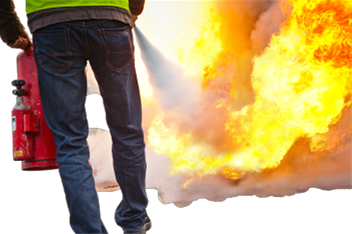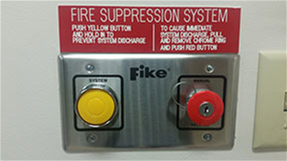Yaskawa has developed this fire prevention plan to reduce the risk of potential injuries, death and property damage. This plan’s purpose is to identify and control fire hazards.
A fire watch shall be assigned for welding and/or flame cutting operations in areas where fire danger exists. The fire watch is to remain for a period after work stops to be sure that no fire exists.
All associates shall inspect their work area and equipment for fire hazards each day. Report unsafe conditions by calling 262-391-1697.
Avoid piling trash and other flammables.
Keep fire exits clear.
Use extra caution around gas, flammable, and oxygen equipment.
Fires are classified according to the type of fuel or material:
Flammable materials shall be stored away from sources of ignition and areas where hot work is performed.
Flammable material storage areas shall be clearly marked with signs denoting:
Multi-purpose fire extinguishers are conspicuously located within each Yaskawa facility. These ABC dry chemical extinguishers are effective on class A, class B and class C fires. Do not attempt to use these extinguishers on class D fires.
The primary purpose of fire extinguishers is to get people safely to building exits.
Trained volunteers may extinguish very small fires, but:
EXCEPTION: The fire alarm does not need to be activated for very small fires resulting from lab testing, product testing, or welding, where the fire is immediately extinguished.
The fire alarm shall be activated if the fire cannot be immediately extinguished.

If you must use an extinguisher, remember to PASS:
Pull the pin,
Aim at the base of the flame,
Squeeze the trigger, and
Sweep the nozzle from side to side.
Some data centers within Yaskawa are protected with a Halon system. This system will remove oxygen from the room. Therefore, exit the room immediately. If you cannot exit, hit the Halon E-Stop and use the ABC fire extinguisher to safely exit the room.

Breaching this policy may result in an injury. Breaches of this policy may result in disciplinary action being initiated in accordance with Yaskawa America's discipline policy.
Fire prevention and protection training is included in new associate and refresher safety training.
Fire extinguisher training is provided to any associate who requests it.
Associates who are required to use fire extinguishers and associates who volunteer to use fire extinguishers receive annual re-training that includes hands-on use of the fire extinguisher.
| Rev # | Description | Release Date | Approved by |
|---|---|---|---|
| 0 | Initial Release | 4/17/2016 | Thurwanger |
| 1 | Added Halon System | 5/31/2017 | Thurwanger |
| 2 | Added "Associates who are required to use fire extinguishers and associates who volunteer to use fire extinguishers receive annual re-training that includes hands-on use of the fire extinguisher. " | 9/8/2021 | Thurwanger |
| 3 | Updated images | 4/28/2024 | Thurwanger |
| Review Date | Reviewed by | Changes Required (Yes/No) | Revision # if updated |
|---|---|---|---|
| 2/15/2017 | Thurwanger | Yes | 1 |
| 1/12/2018 | Thurwanger | No | |
| 1/18/2019 | Thurwanger | No | |
| 1/14/2020 | Thurwanger | No | |
| 1/26/2021 | Thurwanger | Yes | 2 |
| 1/18/2022 | Thurwanger | No | |
| 1/13/2023 | Thurwanger | No | |
| 1/16/2024 | Thurwanger | Yes | 3 |
| 1/21/2025 | Thurwanger | No | |
Policy Video
